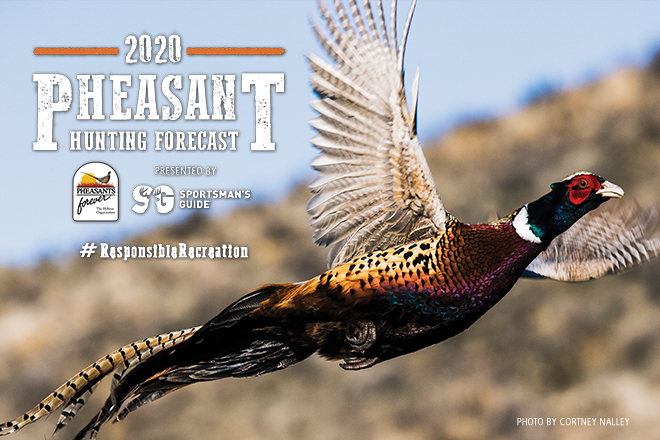
An abnormally hot, dry summer makes for scattered pheasant reports in Texas. Monitoring conditions and searching for pockets of pheasants could be critical this season
By Andy Fondrick, Digital Marketing Specialist at Pheasants Forever
Editor’s Note: If you’re reading this forecast, you must hunt pheasants. If you hunt pheasants and don’t belong to Pheasants Forever or you need to renew, it’s time. Since inception, PF has impacted over 19 million acres of habitat, and created over 200,000 acres of permanently public wild places to hunt and recreate. Upland habitat, public lands and hunting heritage need you. Join, renew or extend and for a limited time get a sweet PF Field Hoodie to boot!
Inconsistent weather conditions and scattered pockets of pheasant populations will make for a challenging, but huntable season in Texas this year. Doing your homework and scouting areas with better habitat, irrigation runoff and isolated areas of higher rainfall may be necessary to find longtails across the Panhandle.
WEATHER AND CONDITIONS
“We had a relatively mild winter with no extended periods of extreme cold or snow, the birds made it through the winter fine,” says Robert Perez, upland game bird program supervisor with Texas Parks and Wildlife Department.
Much like other regions of pheasant country, the winter months weren’t the problem in terms of challenging upland conditions effecting bird populations.
“There was optimism heading into spring for a good nesting season because of good soil moisture and decent cover,” says Perez. “However, the Panhandle experienced consistent high temps and winds in late spring and summer months. The drought conditions continued throughout the summer for most areas.”
Derek Wiley, coordinating wildlife biologist with Pheasants Forever & Quail Forever, noted there were also some dramatic differences in conditions and weather across the state.
“Spring and Summer conditions for pheasants have been a little all over the map for Texas with some areas receiving decent moisture and some areas being incredibly dry,” Wiley added.
HABITAT, BROODS AND COUNTS
Differences in weather conditions naturally created some vast inconsistencies when it comes to habitat and bird populations in the state as well.
“Upland habitat is in fair to poor condition currently, with CRP and managed corners being the best available habitat areas,” says Perez. “Playas were in good shape from moisture received last fall and winter, and if they were not grazed should still be good habitat leading into the fall.”
“There should be good quality habitat in areas that received rainfall,” says Wiley. “There are portions of the panhandle that have not had much moisture at all this summer so habitat quality varies drastically.”
According to Perez, the drought conditions resulted in a poor hatch and brooding year. The trends of the state’s roadside survey history is shown below, but it seems as though Texas is still trying to recover from the drought of 2011-12.
| Year |
2010 |
2011 |
2012 |
2013 |
2014 |
2015 |
2016 |
2017 |
2018 |
2019 |
| No. of Routes |
44 |
44 |
44 |
41 |
44 |
44 |
44 |
44 |
44 |
44 |
| Birds Sighted |
1,208 |
126 |
25 |
15 |
43 |
210 |
276 |
176 |
62 |
129 |
| Birds/route |
27.45 |
2.86 |
0.57 |
0.37 |
0.98 |
4.77 |
6.27 |
4.00 |
1.41 |
2.93 |
| Miles Surveyed |
880 |
880 |
880 |
820 |
880 |
880 |
880 |
880 |
880 |
880 |
| Birds/Mile |
1.37 |
0.14 |
0.03 |
0.02 |
0.05 |
0.24 |
0.31 |
0.20 |
0.07 |
0.15 |
“Among folks in the luckier areas, I’m hearing average reports,” says Wiley. “But based on visiting with folks across the panhandle, our pheasant numbers will be average to below average.”
TOP SPOTS
While it will take some work to find the hidden habitat, Perez and Wiley both have a few places to start your search this season.
Perez recommends Dallam, Hartley and Deaf Smith counties in the western Panhandle for your best bet at finding roosters this fall.
Wiley would start with the northern Panhandle before moving on to the central and southern regions of the Panhandle, in that order.
INSIDER TIP
With limited habitats and crops, there are a few tips that can be offered up for the 2020 season.
“Come early in the season to the areas mentioned above,” says Perez. “A good dog will be essential as birds will be hard to find. It sounds like a lot of folks are in cotton this year so seek out landowners with weedy playas or CRP close to cut milo fields.”
Wiley also notes Milo fields as a key component to success.
“Pheasant country in Texas is all high plains cropland,” he says. “Finding corners that are planted to grass around a milo field would be the best bet. Public land is limited so be sure to ask for permission.”